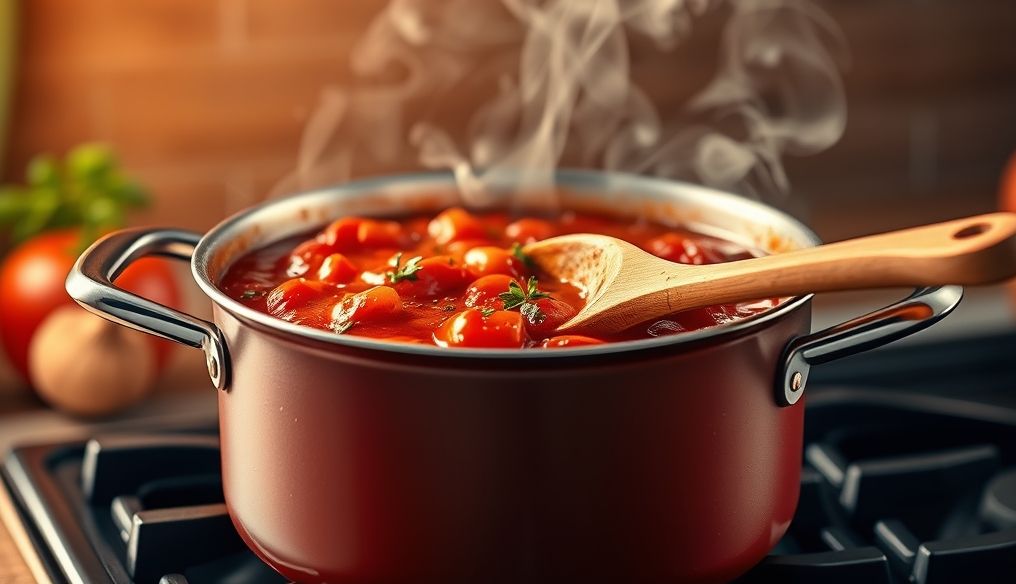Introduction: The Magic of Homemade Tomato Sauce
Tomato sauce is more than just an addition to pasta; it's the soul and beating heart of the dish. A good tomato sauce transforms a simple meal into an unforgettable dining experience. In this comprehensive guide, we will explore everything you need to know to make the perfect homemade tomato sauce, from choosing the right tomatoes to mastering cooking techniques.
Chapter 1: Choosing the Perfect Tomatoes
The foundation of any great tomato sauce is the tomatoes themselves. The quality of the tomatoes used determines the final flavor of the sauce. Here are some types you can choose from:
- San Marzano Tomatoes: Considered the best for making sauce. They are characterized by their dense flesh, few seeds, and natural sweetness.
- Roma Tomatoes: Another excellent option, they are similar to San Marzano tomatoes but less expensive.
- Garden Tomatoes: Can be used if they are fully ripe and have a strong flavor.
Tip: Look for tomatoes that are heavy for their size, deep red in color, and free of any bruises or blemishes.
Chapter 2: Other Essential Ingredients
In addition to tomatoes, there are other ingredients that play a crucial role in the flavor of the sauce:
- Olive Oil: Use extra virgin olive oil for a rich flavor.
- Garlic: Adds a deep and pungent flavor.
- Onion: Adds sweetness and complexity.
- Herbs: Basil, oregano, and parsley are excellent choices.
- Salt and Pepper: Essential for enhancing the flavors.
- Sugar (Optional): A little sugar can be added to balance the acidity of the tomatoes.
Chapter 3: Initial Preparation of Tomatoes
Before you start cooking, the tomatoes must be properly prepared:
- Washing the Tomatoes: Wash the tomatoes thoroughly to remove any dirt or pesticides.
- Peeling the Tomatoes (Optional): If you prefer a smooth sauce, you can peel the tomatoes. There are several ways to do this:
- Blanching Method: Make a small "X" cut on the bottom of each tomato. Place the tomatoes in boiling water for 30-60 seconds, then transfer them to a bowl of ice water. The skin should come off easily.
- Using a Vegetable Peeler: Tomatoes can be peeled using a vegetable peeler, but this method may be more difficult.
- Removing the Seeds (Optional): If you prefer a smoother sauce, you can remove the seeds. Cut the tomatoes in half and squeeze out the seeds.
- Chopping the Tomatoes: Chop the tomatoes into small cubes or crush them using a food processor.
Chapter 4: Basic Cooking Steps
Now, it's time to start cooking the sauce:
- Heating the Oil: Heat olive oil in a large pot over medium heat.
- Sautéing the Onion and Garlic: Add the chopped onion and cook until translucent. Add the minced garlic and cook for another minute until fragrant.
- Adding the Tomatoes: Add the chopped or crushed tomatoes to the pot.
- Adding Herbs and Spices: Add the herbs, salt, and pepper.
- Simmering: Reduce the heat to low and let the sauce simmer for at least an hour, or until it becomes thick and rich in flavor. The longer it cooks, the better the flavor.
- Stirring Regularly: Stir the sauce regularly to prevent it from sticking to the bottom of the pot.
Chapter 5: Improving Flavor and Consistency
After cooking, there are several ways to improve the flavor and consistency of the sauce:
- Adjusting the Spices: Taste the sauce and adjust the spices as needed. You may need to add more salt, pepper, or herbs.
- Adding Sugar: If the sauce is too acidic, add a little sugar to balance the acidity.
- Pureeing (Optional): If you prefer a very smooth sauce, you can puree it using an immersion blender or food processor.
- Thickening (Optional): If the sauce is too runny, you can let it simmer longer or add a teaspoon of tomato paste.
Chapter 6: Adding a Personal Touch
Feel free to add a personal touch to your tomato sauce. Here are some ideas:
- Vegetables: Add other vegetables such as peppers, carrots, or celery.
- Meats: Add ground meat, sausage, or bacon for a meatier sauce.
- Chili Peppers: Add chili flakes or hot sauce to add heat.
- Red Wine: Add a little red wine while cooking for a rich and complex flavor.
- Parmesan Cheese: Add a piece of Parmesan cheese rind while cooking to add umami flavor.
Chapter 7: Ways to Serve Tomato Sauce
Homemade tomato sauce is perfect for many pasta dishes:
- Spaghetti: A classic, simple, and delicious dish.
- Lasagna: An essential ingredient in lasagna.
- Ravioli: A great sauce for stuffed ravioli.
- Pizza: Can be used as a base for pizza.
- Grilled Vegetables: Can be used as a sauce for grilled vegetables.
Chapter 8: Storing Tomato Sauce
Tomato sauce can be stored in the refrigerator for up to 5 days or in the freezer for up to 3 months:
- Refrigeration: Place the sauce in an airtight container and store it in the refrigerator.
- Freezing: Place the sauce in freezer bags or airtight containers and leave a little space for expansion.
Tip: When reheating frozen sauce, thaw it in the refrigerator overnight or in the microwave. Then heat it over low heat until it is completely hot.
Conclusion: Making the perfect tomato sauce for pasta is an art and a science. By following these steps and tips, you can prepare a delicious and flavorful homemade tomato sauce that rivals any store-bought sauce. Enjoy experimenting with different recipes and adding your personal touch to create a unique tomato sauce.




